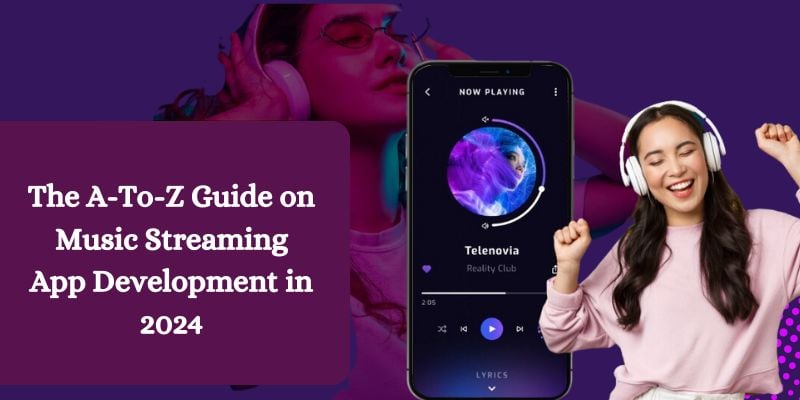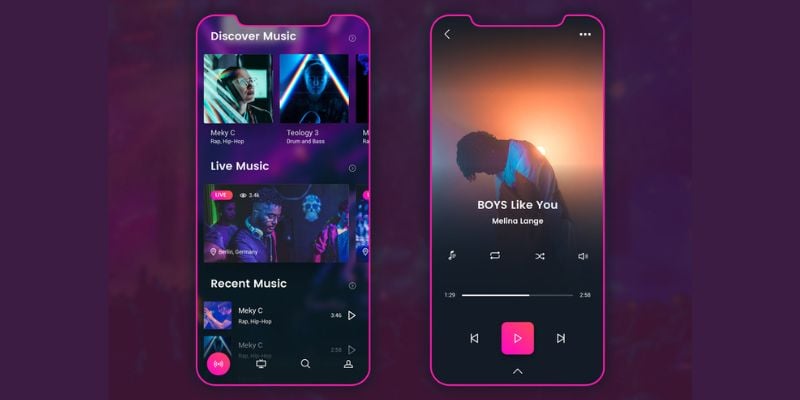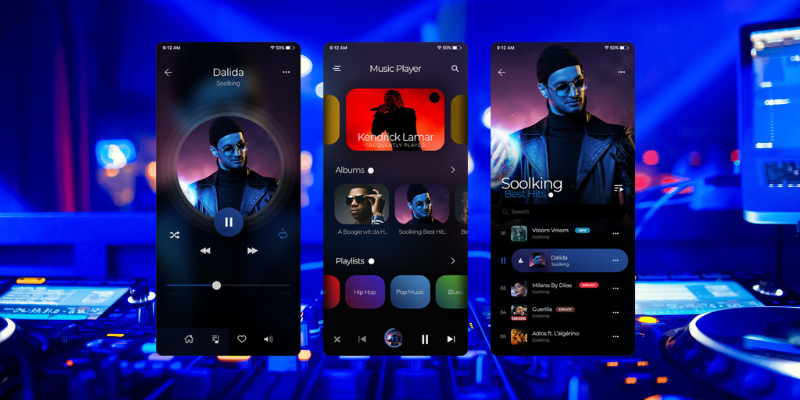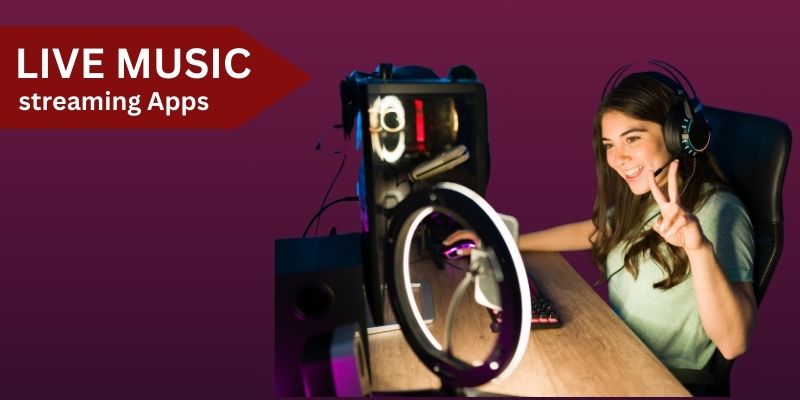The live music streaming app development and audio streaming app solution businesses have multiplied, particularly after the pandemic, which saw everything go digital. The industry has been well-adjusted to the modern world. They've gone through a lot, from waiting for the films to air on TV after theatrical releases to watching anytime through online platforms. The viewership has also grown. In this article, we will discuss how to make music apps.
If the television and film industries have been growing in the past, so has the music industry. Remember when we downloaded the latest music online and shared the songs via Bluetooth? It indeed required some serious effort and time. But you don't have to download these to hear them nowadays. With only a couple of taps, you can listen to any song you wish to through a music streaming app or website. Let's discuss some details and provide an overview of themusic streaming app development solutions market.
What are The Music Streaming Apps?
Many live music streaming app development offer a distinct collection of features and content. Some of the most popular are Spotify, Apple Music, Google Play Music, Amazon Music, and Tidal. These platforms give users access to the largest selection of songs as well as playlists, podcasts, and playlists that allow for a varied and customized music listening experience.
Types and Examples of Music Streaming Apps
Here's a listing of various Music streaming apps, along with a sample.
On-Demand Streaming Services
Spotify: Spotify has an extensive collection of playlists, songs, and podcasts. Users can make customized playlists and discover many genres.
Subscription-Based Services
Apple Music: Apple Music provides a subscription-based model with an extensive music library. Users have access to exclusive content and enjoy a free service without ads.
Internet Radio Services
Pandora: Pandora utilizes algorithms to create custom radio stations based on users' preferences. It offers a variety of new and familiar tracks.
High-Fidelity Audio Services
Tidal: Tidal is known for its top-quality streaming audio. Tidal offers lossless audio and exclusive content that appeals to audiophiles.
Platform-Specific Services
Amazon Music: Amazon Music is integrated into Amazon Echo devices, offering a seamless experience to Amazon ecosystem users. It provides an extensive collection of music.
User-Generated Content Platforms
SoundCloud: SoundCloud allows artists to post and distribute their songs directly to other users. Users can search for a diverse selection of new and independent artists.
Free Ad-Supported Services
YouTube Music: YouTube Music offers an assortment of tracks from official sources, including user-generated content and music videos. Users can download a free, ad-supported version or opt to upgrade for premium features.
Read Also: Comprehensive Guide to Music Streaming App Development for 2024
Essential Features of a Music App
A cross-platform music streaming app development is a complex application featuring a variety of distinctive features. This blog will focus on the essential aspects you should consider when creating an app for streaming music. Before we begin, note that this list doesn't include crucial functions like authorization and integration with social platforms, push notifications, or share music features, as you will get this vital feature in virtually every mobile app development project.
Audio Streaming
Streaming is a method of transmission that lets you quickly locate and transmit continuous audio or videos via an Internet connection. It allows users to listen to songs purchased by the service upon demand rather than buying them independently.
Looking for Music
The search feature will help your listeners find any music or podcast. It is beneficial to offer various tags for searching using the artist's name, the song, the album label, or the genre.
Music player
A typical music player has an easy and user-friendly interface. It includes an audio stream of the track, a volume control, and buttons to play and switch to the next song. The interface also displays the album's cover. Instead of the front cover, specific audio streaming applications show music videos. This can make the player more enjoyable; however, it is essential to ensure it only consumes a little of the user's Internet traffic.
AI recommendations
Artificial intelligence is an essential element of a live music streaming app development. Many people want to explore new genres, artists, and music styles, so users are willing to listen to suggestions based on their preferences in music and listening habits. It is possible to ask users to highlight songs they genuinely enjoy or dislike to ensure that AI can track their preferences.
Playlist
With this feature, users can save the songs they like on a streaming application and then create their playlists using them to help with different situations or routines, such as "workout" or "study."
Lyrics display
Many music streaming apps allow you to demo song lyrics; however, some apps can sync the lyrics to the music being played. This is, for instance, the way Apple Music does. It lets you search for and listen to a particular track, which is incredibly practical.
Downloading
It's a great feature to download your favorite tracks to a streaming music application and then enjoy them, say when you're running in the woods when the Internet connection is not always stable.
Radio and Podcast
The most well-knownmusic streaming app development solutions also have a radio and a collection of podcasts or audiobooks.
Read Aboiut: How to Build a Music Streaming App Like Spotify
Advanced Features of a Music App
Innovative concepts are crucial to keeping users entertained and competitive in music streaming. Beyond the essential functions such as playing music or searching for music, advanced features can be incorporated to allow users to enjoy higher levels of enjoyment from music.
Music social network
Create a similar Facebook-like platform but modify it to meet the demands of music fans. Allow customers to connect with the people they know, keep track of their favorite artists, and share their love of music. This would be similar to having a music community on the streaming platform.
Customizable user profiles for users
This allows users to make their profiles precisely as they would like. For instance, they can choose their photo, add an interesting background, and tell people about their most loved songs and artists in this manner.
Music based on mood
This feature lets you create playlists based on your mood. Select a few filters that describe your mood. If you're content, the streaming service will play happy songs. If you're calm, the streaming service will select more peaceful songs.
The tracking of a concert
This streaming platform keeps its users up-to-date on when their favorite artists are set to perform live in their region or elsewhere. It's like having a calendar of the events they'd like to go to. You may join with other ticketing offices and charge advertising costs.
One example of such a solution is Songkick. It lets users look up music events in their local area and purchase tickets. They also integrated with Spotify, allowing users to see concert dates through Spotify artists' pages.
Recognition of songs
Let's say you're out and about and listen to a tune you like but need to know its name. The feature will let you listen to and learn the song's name. After that, you can add the track to your playlist and listen to new music tracks in the application.
Meditation and music therapy
Create playlists specially designed with music or meditation to assist users in relaxing, concentrating, or easing stress. This feature helps improve users' emotional and mental well-being and transforms a streaming service into a source of relaxation.
Cross-platform syncing
Ensure users' music and playlists are identical across all devices, like smartphones, computers, laptops, or smart speakers. Then, users can quickly toggle between apps and music streaming websites.
Music suggestions from other users
It's similar to receiving music suggestions from a large number of users. Users create playlists and then share them with other users. Popular playlists can help listeners discover new music and artists using their favorite streaming site or application.
Music Streaming App Development Process
Here is a brief overview of the steps to follow to build an application for streaming Music like Spotify:
Refine Your Idea
The first step in developing anything begins with an idea. Start by creating the concept for the app. You can get the idea (not take a copy) from a different streaming app such as Spotify or Pandora. If you plan to develop an iOS music streaming application, study the Apple streaming audio app and the app development procedure. This list includes the top OTT platform development companies.
Research The Music Streaming Market
If you want to outdo your competition or be in the same class, it is essential to understand the game well. Study your competition and the market. Note down every one of their advantages and disadvantages. Find out why music lovers prefer streaming apps, streaming services, streaming services, or music streaming services over others.
An in-depth analysis will help you identify any loopholes within your competition app and help you avoid them for your music application. Additionally, this study can be helpful as you refine your music app's USP. Your USP will allow you to make yourself stand out from the crowd. It's also an essential factor in attracting attention. Also, hire music streaming app developers who will help you know about live music streaming app development.
Define Your Target Audience
Following your research of the competition, determining your ideal customer is the next step. Because they are the people who are likely to use your music apps or audio streaming applications, it is essential to identify them.
Find the age range, possible preferences, gender, locations, and more. Using these data, it is possible to incorporate features that will appeal to the users. For example, the app Spotify can be enjoyed by every age group. Therefore, any app user can stream the latest tracks in addition to tracks from the 1950s or the 60s.
In addition, it has music from various genres, including devotional music and indie music streaming. Since it can cater to an extensive audience, it can listen to music in 62 languages. Undoubtedly, it holds an impressive share of the music streaming market.
Select the Type of App You'd Like to Create
The three most popular kinds of music streaming services are:
Music Library The Library of Music provides its patrons with pay-per-use or free access to music tracks. For example, Spotify and Apple Music.
Cloud-based music streaming: Cloud-based streaming apps let users save their music tracks and listen to them at any music anywhere. For example, Groove Music.
Radio stations The radio station app lets users listen to various radio stations in a particular order. It can be streamed to other devices, such as PCs and mobile phones—for example, Shoutcast.
Check out the App's Features:
After deciding the type of app you'd like to use, you need to choose the features you want to include in your app development. That's where information collected from your research will come into play. There are two types of features: MVP and advanced. MVP refers to must-have features. They are the non-negotiable, unskippable essential features in a music streaming app.
Advanced features, however, need to be tied. You can also add advanced features in the future or after you release your music streaming app. For music, these MVP features include sign-up settings such as searching, the player, and my library.
Select the Platform
An online music streaming application is available for iOS and Android. Streaming services are also available across all platforms and compatible with every operating system. Therefore, you must decide which platforms to provide your music streaming service. The choice is based on the platform for which you'll need to hire music streaming app developers.
Onboard Music Streaming App Development Team
Cross-platform music streaming app development isn't a joke. After you have finalized your platforms and features, you can engage experts to develop music apps. To do this, you'll need to hire music streaming app developers, as well as experts like:
Project managers
business analysts
Android app developers
iOS app developers
web developers
UI/UX designers
Backend developers
QA engineers
Android and iOS have various programming languages.
In addition, you'll require a scalable tech stack and a database. You also need to determine how you'll keep the information. You will need an end-to-end server that is compatible with streaming, such as AWS.
As a business owner, you'll have to give your team a substantial amount of time to develop mobile Music streaming applications. It takes about 155 hours to complete the backend of thelive music streaming app development to create the MVP version. In the same way, it takes about 359 hours to complete iOS and Android live music streaming app development to make the MVP version.
Additionally, it would help if you allowed your web developers the time needed to create an admin panel. They will need nearly 431 hours to build the admin panels for all applications. Design is an essential part of the app, too. It determines user satisfaction and user-friendliness. In order to create a user-friendly design for your live music streaming app development, the designers you choose will need at least 150 hours on one platform.
When your app is finished, you can put it out in the marketplace and observe the consumer's behavior. Based on the users' reports, make changes and add additional features or improve on the ones you already have in place to stay ahead of the race!
Also Read: Music Streaming app development Cost based on clone vs apps built from scratch in 2024
Music Streaming App Development Stages
Conceptualization and Planning
The app's goal and audience, functions, and features. Make a detailed plan that includes the technology stacks, platforms (iOS, Android),and any integrations with third-party companies.
Design and Prototyping
Develop the User Interface (UI) and user experience (UX) layout. Create wireframes and prototypes to show the layout, navigation, and overall layout.
Development
Implement the features planned and designed using programming languages such as Java (for Android) or Swift (for iOS). Create the backend infrastructure that supports audio streaming, user accounts, and content management.
Testing and Quality Assurance
Conduct thorough testing to discover and eliminate bugs while ensuring the application functions smoothly. Examine user interaction, audio streaming capabilities, and compatibility with different platforms and devices.
Deployment and Maintenance
Start the app in the preferred app store (Google Play Store, Apple App Store). Review user feedback, resolve any issues that arise post-launch, and then implement changes or new features according to user requirements and industry trends.
How much will it Cost to Create a Music Streaming App?
Live music streaming app development with best features will cost between $15,000 and $25,000. Your budget will need to be boosted to make a music application that works for iOS and Android and integrates third-party API services.
Calculating the costs associated with creating a music streaming app requires looking at various variables, including features and plugins available for this genre, the platform in which it will be launched and its style. Key components should then be combined and divided by hours dedicated to developing each function of the application - cost estimates range anywhere from hundreds of thousands to dollars when planning fully format music apps.
Let's examine the costs associated with streaming music apps:
- Basic App development- $30,000 to $70,000
- Medium App Development- $70,000 to $1,00,000+
- Complex App Development- $1,00,000 to $200,000+
Conclusion
Cross-platform music streaming app development requires serious planning and effort. If you intend to create an app that is a Spotify replica or an application similar to Spotify, it is essential to follow the steps. The process of developing apps can seem overwhelming, but it's easy when you know the process. Clearing the features you want to include and the structure will make it easier to create apps. It can also help you find experts who can create effective music streaming apps.
Hire Music Streaming App Developersfor perfect music streaming app development solutions. They can create an app similar to Spotify, Gaana, and Saavn for a reasonable price. Their team is proficient in various kinds of app development for streaming, such as Music sharing apps, radio app development, music and podcast apps, and more.








